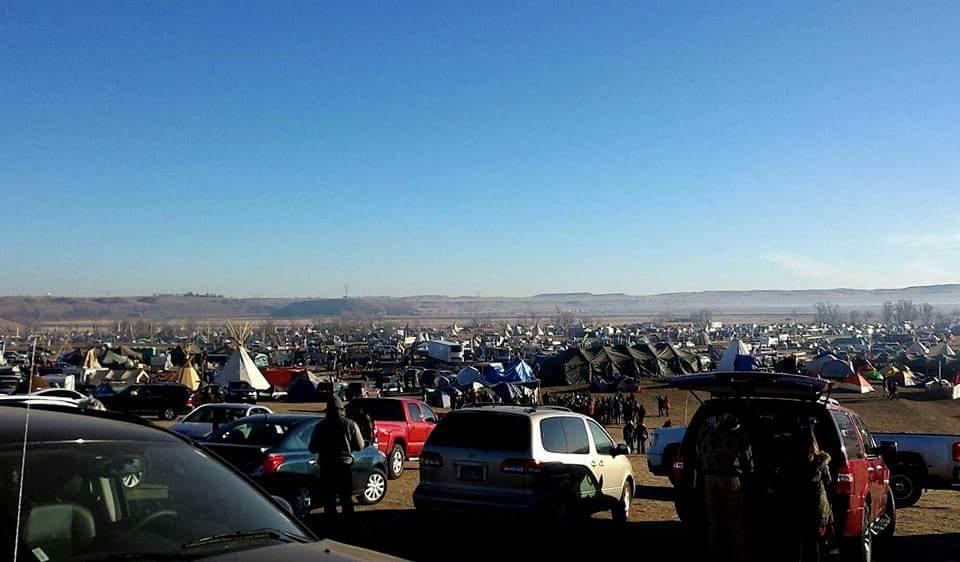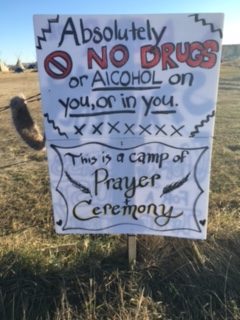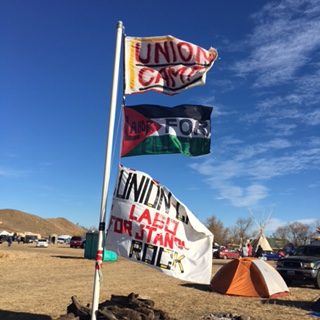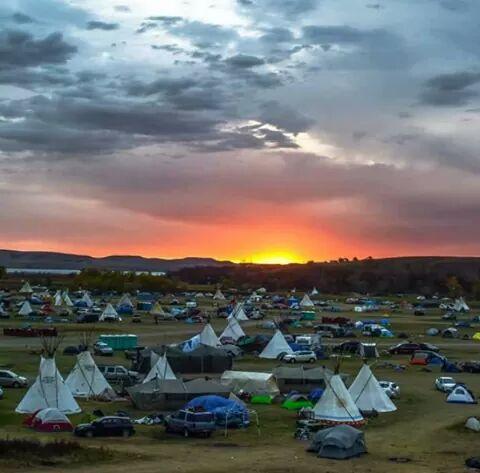
by Nancy Romer
In this report, I will try to give you a sense of what being at Standing Rock is like. Tonight completes my third day here. The weather has been mostly cold but very sunny. The colors, the sky, but most of all the people are startlingly calm and beautiful. The Standing Rock encampment is defined as a prayer site, a place to contemplate and to appreciate nature, “the creator” (not my words), and each other. The Indigenous people here from just about every tribe in the US and some from Canada are so welcoming and warm to outsiders. They repeatedly say how much they appreciate the presence of non-Indigenous folks and how they want to share with us. They are strict on the rules: no violence of any kind, no drugs, alcohol or guns, respect for Indigenous ways, making oneself useful.
The vast encampment contains 4 or 5 separate but connected camps, some on the Sioux reservation land, others outside.The largest one is immediately off reservation land, Oceti Sakowin Camp; it is the one in which most of the activities happen. The others are either defined by age—elders or youth—or vary by activity. We spend most of our time at Oceti but today I took a long walk and visited two of the other camps just to get a flavor of them.
NO DAPL stands for No Dakota Access Pipeline and signs with the slogan are everywhere as is “water is life”. There is a religious feel to the camps and great respect all around. In many ways this is a very old-style Indigenous encampment and in many ways it feels like a post-revolutionary or post-apocalyptic future.
The pace is slow though everyone seems to move with great purpose. People jump in and do the tasks that seem to be needed: cooking, cleaning, helping each other to put up a yurt or a teepee, chopping wood, tending fires, washing dishes, offering legal, medical or psychological help. Cell and internet service is miserable and probably interfered with by the constant drones that fly above the camps.
For me the most impactful point was respect. They defined that as including slowing down, moving differently with clearer intention and less reactivity.
On Friday I attended a brilliantly presented orientation to the camp. One of the presenters was Maria Marasigan, a young woman who was active in the Brooklyn Food Coalition. It was the best anti-racist training for allies that I have witnessed: succinct, not guilt-trippy, and very direct. The three main rules are: Indigenous centered, build a new legacy, and be of use. They shared the Lakota values that prevail in the camp: prayer, respect, compassion, honesty, generosity, humility, wisdom.
For me the most impactful point was respect. They defined that as including slowing down, moving differently with clearer intention and less reactivity. They suggest asking fewer questions and just looking and learning before our hands pop up and we ask to take up space.

They clarified a gendered division of behavior and practice, including asking women to honor traditional norms of wearing skirts during the sacred rituals (including in the cooking tent) and for women “on their moons” to spend time in a tent to be taken care of and rest if they choose. Somehow it seemed okay, actually respectful, not about pollution and ostracism.
While I was helping out in the cooking tent—my main area of contribution—an Indigenous woman came by with about 10 skirts and distributed them to the mostly women in the cooking tent and we gladly put them on. It served as an extra layer of warmth over my long underwear and jeans. It was not what I expected but it seemed fine to all of us. We just kept chopping away at the veggies.
Later that day I attended a direct action training that was also quite thorough and clear. Lisa Fithian, an old friend from anti-war movement days, lead the training and explained how to behave in an action and how to minimize police violence. Lisa, along with two other strong, smart women, one Black and one Native, laid out a plan to do a mass pray-in in town the next day. My New York City travel companion and I both felt that we couldn’t risk arrest and decided not to join that direct action but to be in support in any way we could.
At 8 am the next morning about 100 cars lined up in convoy formation at the exit of the Oceti Sakowin Camp, each with lots of passengers—including some buses and minivans—and went into Manwan, the nearest town. The Indigenous folks formed an inner circle and the non-Indigenous formed a circle around them. The Indigenous folks prayed, sand and danced. The tactic was exercising freedom to practice their religion while protesting the Dakota Access Pipe Line. No arrests were made despite massive police and drone presence. One local man tried to run over a water protector but she jumped aside; the man had a gun but was subdued by the cops. Lots of videos were taken and the man was brought to the local jail.
On Saturday I finally got a press pass as I got a request to cover the encampment from New Politics, a print and online journal. That gave me the right to take photos (otherwise not allowed), but still limited—no photos of people without permission or of houses or horses, again without permission from the people with them. I set out to interview people at the various camps and to get a sense of what people were planning to do for the winter.
I spoke with Joe, a part Lakota from Colorado who had been raised Catholic and attended Indian residential schools, taken from his parents by the state because they doubted the ability of the native community to raise their own kids. He said it was brutal. When asked why he was here, he replied, “This is the first time since Little Big Horn that all the tribes are uniting against a common enemy—the black snake—the pipeline that will harm our water, our people. This unity is making us whole.”

At Rosebud camp just about a 1/2 mile from Oceti, I discovered a group of people building a straw-bale building that was destined to become a school. Multi took a break to tell me how they came to create this project with the full collaboration of parents and kids in the camp. Their project grew out of a team of people from Southern California who are builders and designers who use earth and straw as materials creating almost no carbon footprint and providing both strength of structure and extraordinary insulation—very important for a windy and cold winter ahead.
“We spent five days gathering ideas from people at the camp as to what they needed. They decided on building a school for the many kids who might stay the winter or come and go over time.The parents and kids helped to design the structure with the builders.”
Multi told me, “We didn’t want to bring the colonialist idea of what was needed and just tell people at the camp. We spent five days gathering ideas from people at the camp as to what they needed. They decided on building a school for the many kids who might stay the winter or come and go over time. The parents and kids helped to design the structure with the builders. All the decision-making was ‘horizontal’, engaging everyone with equal voice, avoiding hierarchy. It will be a one-room schoolhouse with nooks for specific tasks and will serve K-8th graders.” A teen center is being built nearby.
When I visited there were five women and one man working on the project and they welcomed any help they could get to finish the project before the cold sets in. When I asked Multi why she was doing this project she said, “For me this is about coming together as a global culture, a people who have the resources we need for future generations. We are here to protect our futures together. Building a schoolhouse is a manifestation of that ancient technology for our future together.”
“This is all about the water and who lives downstream. We are testing a new economic system that requires governance, self-governance from the ground up.”
Down the road I met Danielle who was helping to build a multi-purpose center housing a kitchen, dining area and meeting room. She told me that “This is all about the water and who lives downstream. We are testing a new economic system that requires governance, self-governance from the ground up. The needs must evolve for us to create a system that will fit them.” She is particularly excited about engaging people to serve and to be united, to be able to work together with their passions for service, to be happy together in this way. The materials for the building were donated by people from Ashville, NC and were deeply appreciated. All over the camps one sees evidence of creative problem-solving, cooperation and contributions brought from afar. The “donations” building is brimming with winter clothes (adults and kids), foods of all kinds and practical items.
I was particularly interested in the many families that were at the camps, including lots of kids of all ages, including infants. One family from Boulder, Colorado, with 8-year old Oscar and 11-year old Audrey, were unpacking their car when I came upon them. Their mother, Susan, said, “We are here to support the protest and to have our kids learn from it. I want my kids to understand that we do what we can to take care of the water and support the Indigenous people. To step it up these days we have to hold some ground. This is one of the places we can meet. It would be great if Obama would release the land and kill the pipeline.” Amen.
I encountered a father-son pair from Manhattan. Fourteen-year old Declan Rexer learned about the encampment from a single segment on MSNBC news but couldn’t find anything else about it in the corporate media. He was particularly upset by the police attacks on elderly protesters. He then went to alternative and social media and found an enormous amount of information. His interest grew and his father, William Rexer, decided to bring him out to North Dakota to learn for himself.
They plan to bring back lots of information for Declan’s classmates and encourage more people to come out to see for themselves. William, a media professional himself, connected with some of the young documentarians at the camp and will provide some material support to them in order to advance their work.
“I’ve been here from the beginning and I will stay to the end. All winter if that’s what it takes. We have been colonized and divided for 500 years.”
I spoke with Joseph, a Salish man from Montana. I asked him how long he was planning to stay at the camp. He told me, “I’ve been here from the beginning and I will stay to the end. All winter if that’s what it takes. We have been colonized and divided for 500 years. This is our time to unite and resist. We must protect our water and our tribes.” He thanked me for coming to Standing Rock and being an ally. He asked me to tell my friends to come out and join the encampment, to be water protectors.
Generosity is evident all over the camp. I particularly love working in the kitchen, a huge army tent with large tables, stoves and lots of equipment. On each of the two days that I worked in the kitchen there were about a dozen people busily working in happy unison. There was a chief organizer and then 4 or 5 people who were in charge of a particular dish, each with 1-3 assistants. I was an assistant, happy not to have to mastermind anything. The chatter amongst the workers reminded me of the Park Slope Food Coop squads where people work together with shared goals. As one man put it, “We come together here with one vision. We are building a new world together.”
I am moving slowly and deliberately and thinking about the world we need to build together, on a much larger scale.
While I attend trainings and sacred fire circles, chop veggies, talk with people, drive people around, and walk around the various camps, I am struck by how happy I feel. Sure, this is temporary. Sure, this is not my “real world”. But it is a lovely world, a loving world, a kind world, where each person is greeted with kindness. Young men and women ride through the camps on horseback, connect to ancient traditions, and bask in the glory of a shared culture of resistance. I don’t come from this culture but I do support their determination, their right to protect their land and water and people, their valiant attempt to build a better world. I am moving slowly and deliberately and thinking about the world we need to build together, on a much larger scale. Can we decide to be kind to each other, to collaborate, to try to remove ego from our day-to-day practice? I don’t know the answer to these difficult questions. But I do know that when people share a common struggle we can be beautiful. I bask in that beauty at Standing Rock.

Nancy Romer is a life-long social justice activist starting in the tenants rights movement, then the feminist, anti-war, anti-racist, anti-imperialist, union, food justice and, now, climate justice movements. Nancy is Professor Emerita of Psychology at Brooklyn College and now writes primarily on climate movement-related efforts, with a particular interest in agriculture and peasant movements in Latin America. Read their first report on life at the camp here.
To receive our next article by email, click here.